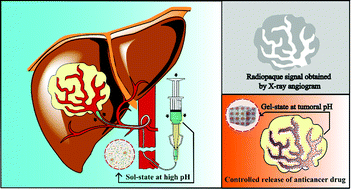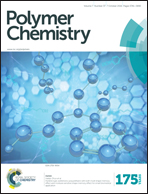A novel sulfamethazine-based pH-sensitive copolymer for injectable radiopaque embolic hydrogels with potential application in hepatocellular carcinoma therapy
Abstract
Transcatheter arterial chemoembolization (TACE) has been the mainstay palliative therapy for unresectable hepatocellular carcinoma (HCC). The conventional TACE systems, comprising of a drug-in-oil emulsion and embolic materials, have been reported to be inconsistent and unable to provide the controlled release of anticancer drugs. To overcome these limitations, we have developed a liquid embolic material formulated from a novel biodegradable pH-sensitive multiblock copolymer that can be intraarterially injected into hepatic tumor sites via microcatheter, and exhibits a sol-to-gel phase transition in response to the local environment to form hydrogels as depots for controlled release of anticancer drugs and suppression of tumor growth. The anionic block copolymer, comprising of poly(ε-caprolactone-co-lactide) (PCLA), poly(ethylene glycol) (PEG) and poly(urethane sulfide sulfamethazine) (PUSSM), named PCLA-PUSSM, was synthesized and characterized. In aqueous solution, the prepared copolymer existed as a liquid at high pH (8.5) and exhibited a sol-to-gel phase transition with decreasing pH. The release of doxorubicin (DOX) from PCLA-PUSSM hydrogels was controlled in a sustained fashion, and the released DOX retained its bioactivity. Radiopaque embolic materials prepared by mixing PCLA-PUSSM copolymer solutions with X-ray contrast agents (e.g., Lipiodol® or Iohexol) and DOX could easily be intraarterially injected to a rabbit hepatic tumor using a microcatheter, and formed hydrogels for chemoembolization. Importantly, after intraarterial injection of the DOX loaded hydrogel into the tumor of a VX2 rabbit tumor model, the formed hydrogel inhibited the tumor growth at 2 weeks post-injection. This hydrogel system provides a potential radiopaque chemoembolization candidate for HCC and other cancer therapies.



 Please wait while we load your content...
Please wait while we load your content...